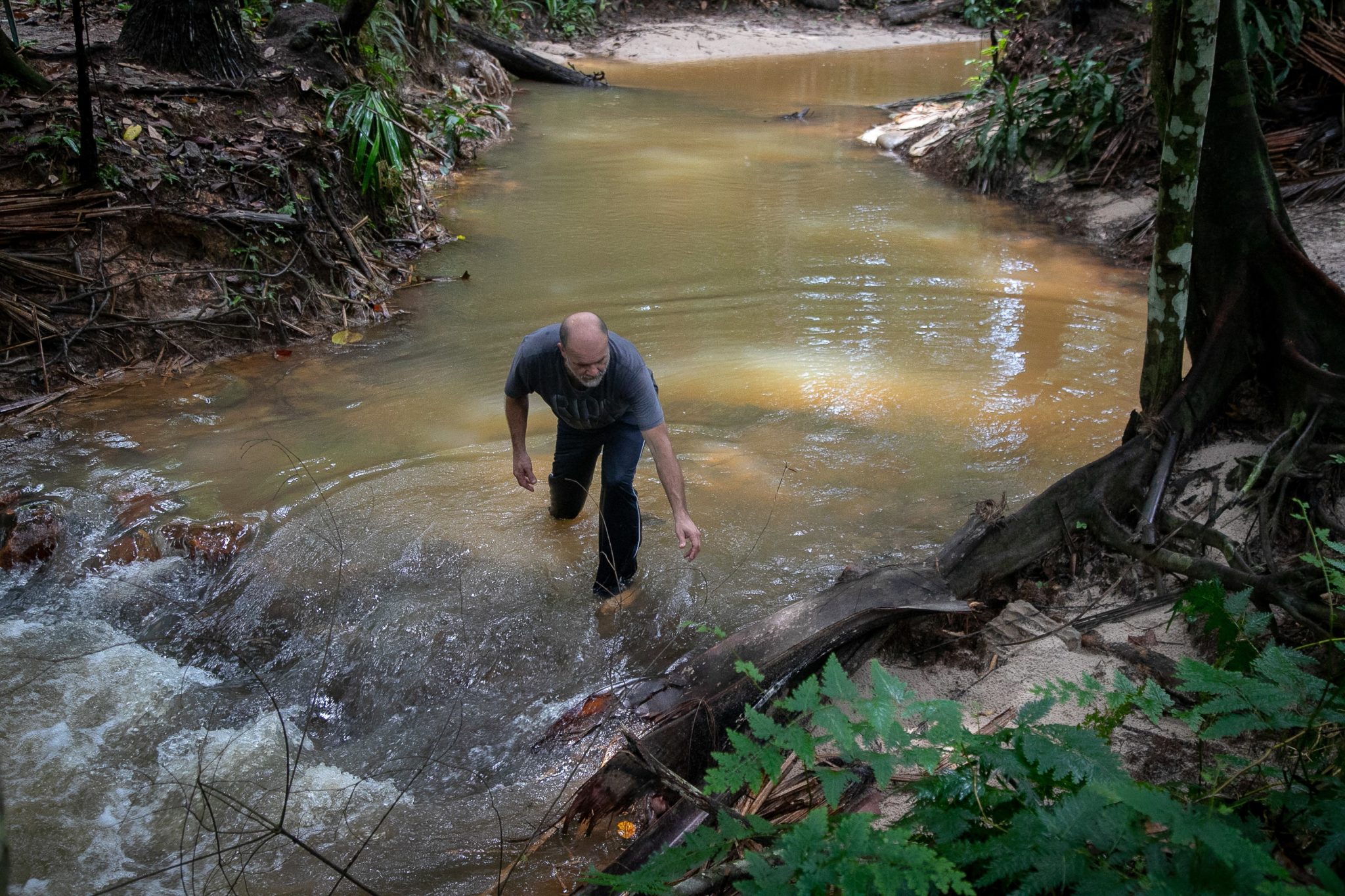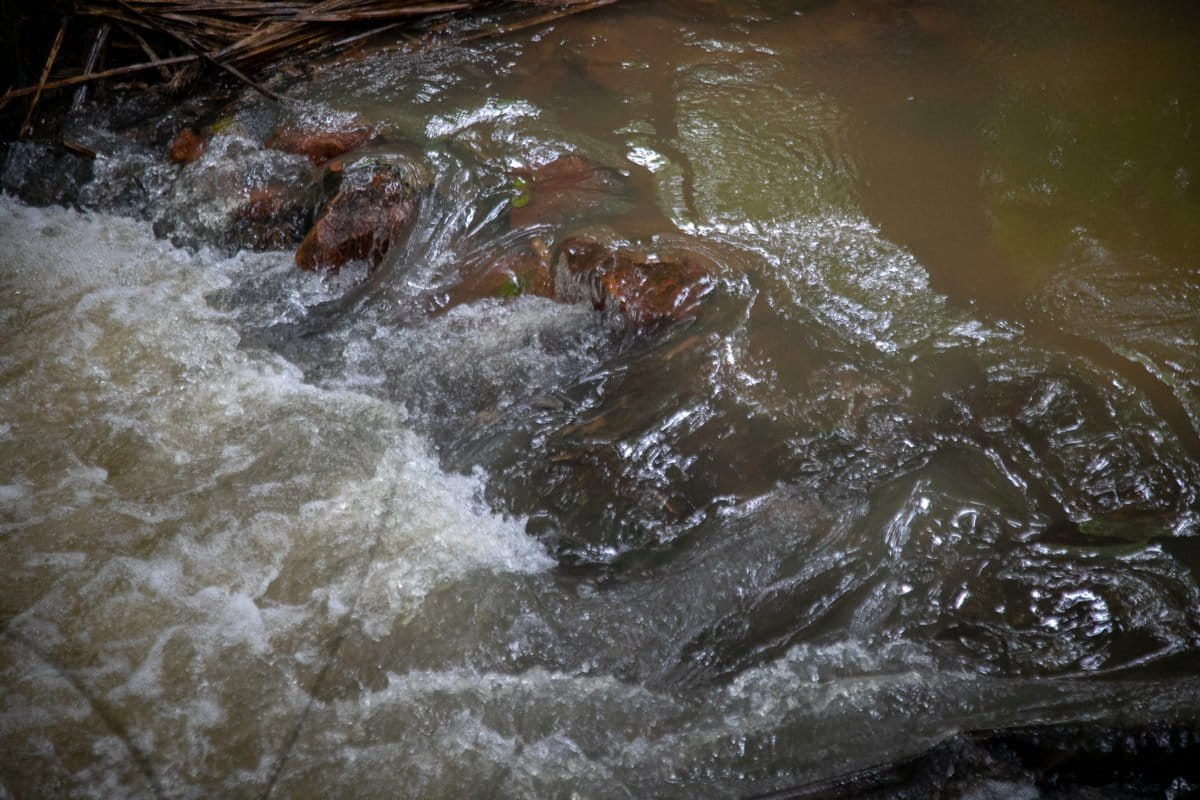- Jó Farah, president of Mata Viva, a local NGO, fights to save a stream called Água Branca, which means “white water,” that he says is the last clean waterway, or igarapé, in the city of Manaus, the capital of Brazil’s Amazonas state.
- Once used for leisure, navigation and fishing, almost all of the 150 igarapés in Manaus are totally polluted, with experts saying it could take up to 30 years for them to recover, while others are considered “dead.”
- Igarapés are important for natural drainage during rainy season, experts say. They warn the problems of flooding will only get worse over time, especially with climate change and related extreme weather conditions, if the issue not addressed properly.
MANAUS, Brazil — At the heart of the Brazilian Amazon, Jó Farah wades knee-deep through the crystal water of a stream that he claims is the last clean one in the city of Manaus, the capital of Amazonas state.
A stream or a little river is called an igarapé in the Amazon region, and this specific one is known as Água Branca, which means “white water” and stretches over Manaus’s Tarumã neighborhood.
“What keeps an igarapé clean? It needs forest, an area of 100 meters [330 feet] of each side in order to keep the water springs alive,” said Farah, the president of Mata Viva, a local NGO working in the region for 19 years.

But this condition hasn’t been respected, he said.
With a population of more than 2 million, Manaus is the most populous city in the Brazilian Amazon, surrounded by the world’s greatest tropical forest and connected by tributaries to the mighty Amazon River.
Once used for leisure, navigation and fishing, today, almost all of the city’s 150 igarapés are totally polluted with trash and other waste, according to activists, residents and the local government.

Experts say that it will take to at least 20 to 30 years for the waterways to recover; some, referred to as “dead igarapés,” are nearly beyond saving as their springs have been blocked with trash or soil.
“The dead igarapés of Manaus, they died silently. [But] this igarapé has a voice,” Farah said.
Farah, a former journalist, maintains a website that updates and monitors the state of the igarapé Água Branca, a form of online activism that he says helps keep the igarapé “alive.”
Today, as a result, the igarapé has attracted researchers from across the city and is monitored remotely by the Federal University of Amazonas (UFAM), which keeps track of its water levels.

Disordered growth
Manaus’s population grew rapidly from the 1970s with the opening of its free-trade zone and thousands of factory jobs. Lacking housing options, many migrants built their homes on the edges of the city’s igarapés.
Today, perhaps the city’s most emblematic example is the Igarapé Educandos, which flows into the Rio Negro, Manaus’s main river and source of water. During the dry season, the Educandos recedes and it’s possible to see all of the trash that has been dumped in it.
Another is the Igarapé do 40, which last year was photographed and published in the local media with what was described as a “carpet” of garbage floating on top.
“Apart from the natural beauty, we are losing opportunities for transport and tourism by not caring adequately for the igarapés,” said Marcos Castro, a professor of geography at UFAM.

Igarapés are important for natural drainage during rainy season, experts say. According to Castro, flooding in the city will only get worse over time, especially with climate change and related extreme weather conditions, if not addressed properly.
“This will lead to greater public health problems in the long run,” he said, citing diseases that proliferate with dirty waters.
Castro’s statement rings true for Manaus resident Cristina Santos, who lives in a favela community in the Raiz neighborhood, an hour’s drive from Manaus’s famous Amazon Theatre.
Santos, 35, is one of thousands of manauaras — as people from Manaus are called —living in precarious dwellings such as stilt homes by the edges of the city’s igarapés.
Each year during the Amazon’s rainy season from November to April, her wooden shack floods as the igarapé fills and overflows.
“People’s belongings get damaged … it’s very dirty and full of animals: snakes, frogs, and rats … our health suffers, and we get sick,” Santos said.
“We residents have to be more aware and not throw stuff into the igarapé,” she said, pointing the riverbanks covered in trash, “but we need the government’s help too.”

Housing shortfall
Manaus has a chronic shortfall of affordable housing, and as the richest city in the Amazon it continues to attract thousands of rural migrants from far-flung interior towns, as well as recent waves of Haitians and Venezuelans fleeing civil strife.
Many of the poorest end up living in informal settlements like Cristina’s, or setting up new ones, that lack adequate sewage and waste disposal infrastructure.
“Each year in Manaus, the number of informal settlements grows,” said Antonio Nelson de Oliveira, the city’s secretary for the environment and sustainability. “This causes great damage to the igarapés.”

But in many poor neighborhoods of Manaus, residents have more immediate concerns than keeping the igarapés clean.
The night before Mongabay visited Cristina’s neighborhood, residents said, there was gunfire and rumors that a young man had been killed in a drug gang dispute.
Manaus is trapped in an ongoing drug war, commanded from the city’s notorious prisons and mainly fought in the city’s poorer communities, between gangs vying for control of local markets and trafficking routes.
Opposite the favela where Cristina lives, low-income buildings built under a state government program to rehouse residents living by the edges of the rivers eject domestic sewage, untreated, into the igarapé.
“This is the scenario of Manaus,” said Sergio Bringel, a water expert with Brazil’s National Amazon Research Institute (INPA).
But it’s not just poor neighborhoods that pollute the igarapés. According to experts, the vast amount of Manaus’ sewage goes untreated.
“Factories and luxury condominiums also pollute the igarapés,” said Castro, the UFAM professor.
The result, Bringel says, is both organic and chemical contamination. “This leads to the creation of new bacteria … viruses which can be deadly, especially for children, have already been detected,” he added.
Increasing threats
Polluted igarapés also threaten livelihoods, especially in a city that relies on water for many leisure activities, residents say.
Dorio Farias, 59, the owner of a natural swimming bath that charges for entranceon the northern outskirts of the city, said he was worried pollution encroaching into his pool.
“I don’t know how much longer we will be able to stay open here,” he said.
Just a 10-minute drive from igarapé Água Branca, the Tarumã waterfall provides a frightening contrast.
Used by Manaus residents up until the 1990s as a leisure option, today it is polluted, foul smelling, and the preferred spot for the disposal of dead bodies by criminals, according to residents.
“They built a road directly over the waterfall’s spring. I don’t think anywhere else in the world they would do this,” Farah said.

With the construction of the road, he said, came the formation of irregular settlements in the surrounding region, which polluted the water.
“If a heritage site like this with all of its tourist potential doesn’t survive the city,” Farah said, “what hope does igarapé Água Branca have?”
Banner image caption:
FEEDBACK: Use this form to send a message to the author of this post. If you want to post a public comment, you can do that at the bottom of the page.
